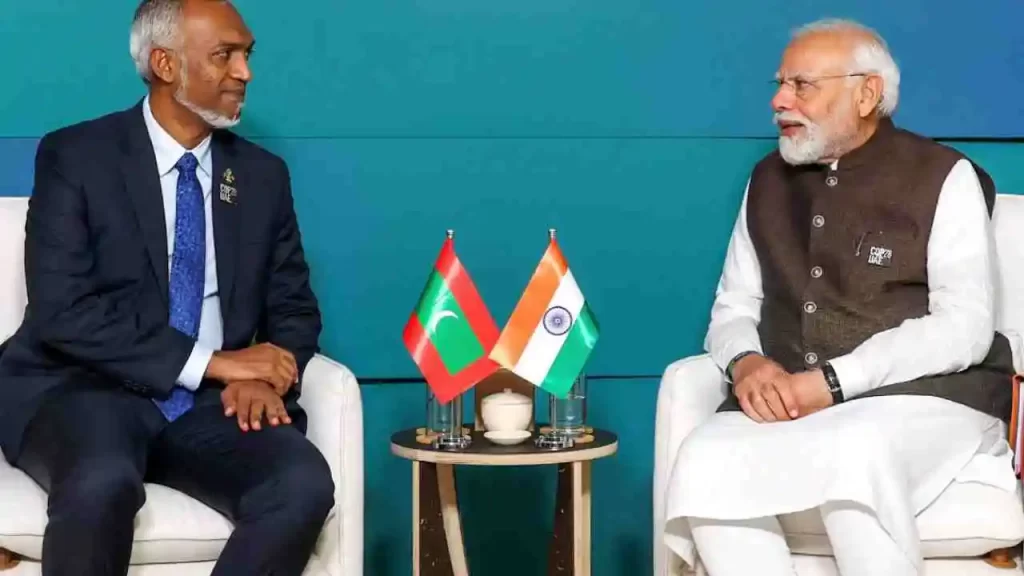
India Lifts Export Ban for Maldives: In a surprising move amidst ongoing diplomatic tensions, India recently lifted export restrictions on essential goods destined for the Maldives. This decision, announced in April 2024, underscores the complex relationship between the two South Asian neighbors, where “Neighborhood First” policy and geopolitical considerations intertwine.
India Lifts Export Ban for Maldives
Underlining its ‘Neighbourhood First’ policy, the Central Government has agreed to increase exports of essential supplies to Maldives for the financial year 2024-25. The decision comes amid the backdrop of rising geopolitical tensions in the Indian Ocean region, particularly in relation to China’s growing influence in the Maldives led by the Muizzu administration and the ‘India Out’ campaign.
India Lifts Export Ban for Maldives
“On the request of the Government of Maldives,” the Indian High Commission in the Maldives said in a statement outlining the Center’s decision to enhance the export of vital products., the Government of India has permitted the export of certain quantities of essential commodities for the year 2024-25 under a unique bilateral mechanism, wherein, the quota for each of these commodities has been revised upward Is. The quantities approved are the highest since the system came into force in 1981.”
I sincerely thank EAM @DrSJaishankar and the Government of #India for the renewal of the quota to enable #Maldives to import essential commodities from India during the years 2024 and 2025.
— Moosa Zameer (@MoosaZameer) April 5, 2024
This is truly a gesture which signifies the longstanding friendship, and the strong…
Enhanced exports amid diplomatic strains
The revised export quota reflects a significant increase in the supply of critical commodities such as river sand and stone aggregates – which are vital to the Maldives’ construction sector – by 25 per cent to 1,000,000 metric tonnes. Additionally, export limits for essential food items like eggs, potatoes, onions, sugar, rice, wheat flour and pulses have been increased by 5 per cent.
This increase in quota is the largest since the inception of the bilateral mechanism in 1981, reflecting India’s commitment to the development and stability of the Maldives.
The central government’s move comes against a complex geopolitical canvas, with China’s assertive presence in the Indian Ocean raising concerns in India. The Maldives, strategically located along key maritime routes, is a focal point in the broader India-China rivalry in the region.
India Maldives Trade: Commodities to be Exported from India to Maldives
India Maldives Trade: In 1981, India and the Maldives signed a bilateral trade agreement, which provided for the export of essential commodities from India to the Maldives.
This year, under its Neighborhood First policy, India has agreed to allow export of essential goods to Maldives despite many items being placed on the restricted list or prohibited list.
The commodities that can be exported to Maldives are potatoes (21,513.08 tonnes), onions (35,749.13 tonnes), wheat flour (109,162.96 tonnes), rice (124,218.36 tonnes), sugar (64,494.33 tonnes), pulses (224.48 tonnes), Stone and river sand (one million tonnes each).
Read more: India Prime Ministers List (1947-2024):Tenures, Facts, and Key Responsibilities
The quantity approved for Maldives is the highest since the 1981 trade agreement between the two countries.
India banned wheat exports in May 2022 and non-Basmati rice exports in July 2023 to reduce prices in the domestic market. Similarly, export of onion was banned in December 2023. However, the Government of India has given permission to export these items. On a case by case basis at the request of friendly countries. India has supplied rice, wheat and onion to countries like Bangladesh, UAE, Bhutan, Mauritius and Indonesia.
What is a Restricted or prohibited item in Trade ?
The goods that can be exported/imported, as stated in the Foreign Trade Policy, are placed in three categories, Open General List (OGL), Restricted and Prohibited List.
Open General List – Goods which are mentioned in the Open General List can be exported/ imported without requirement of any license from the DGFT.
Restricted – This refers to those items which can be imported/exported only with the prior permission of DGFT.
Prohibited – This refers to those goods which cannot be imported or exported from India.
The Directorate General of Foreign Trade (DGFT), under the Union Ministry of Commerce and Industry, is responsible for implementing the foreign trade policy of the Government of India.
India Maldives Relations: How Close are the Maldives to India?
The Maldives are an archipelago in the north-central Indian Ocean. It belongs to the continent of South Asia.
The Maldives are an archipelago of coral atolls formed from the summit of a submerged ancient volcanic mountain range.
The Eight Degree Channel separates the Maldives from the island of Minicoy in Lakshadweep.
All of the islands are low-lying, with none rising more than 6 feet (1.8 m) above sea level. Due to rising sea levels, the Maldives are at risk of submerging into the Indian Ocean.
IThe Maldives is a major supplier of scrap metal to India, with engineering and industrial goods, pharmaceuticals, and agricultural items among its exports.
Frequently Asked Question: India Lifts Export Ban for Maldives
Why did India increase exports to Maldives despite diplomatic tensions?
The move reflects India’s “Neighborhood First” policy, prioritizing regional stability and long-term ties.
What are the key commodities included in the increased quota?
River sand and stone aggregates (construction sector), eggs, potatoes, onions, sugar, rice, wheat flour, and pulses (food items).
What is the significance of the increased quota?
It’s the largest increase since the 1981 agreement, highlighting India’s commitment to Maldives’ development.
What are some restricted or prohibited items in Indian trade?
Restricted items require permission from DGFT for import/export, while prohibited items cannot be traded.
How geographically close are India and the Maldives?
The Maldives are an archipelago in the North-central Indian Ocean, separated from India by the Eight Degree Channel.

Leave a Reply